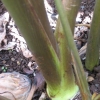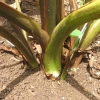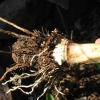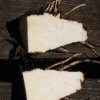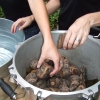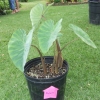Use As Food
A fairly good poi taro, very good table taro. Pololū's ‘ūlika (gumminess) makes it a challenge to ku‘i, pound by hand with stone (pōhaku) and board (papa ku‘i). Good flavor.
Distribution
Grown to some extent in Kohala, Hawai‘i, under lo‘i (wetland) culture, but seldom found elsewhere. Pololū is a hearty grower with a high resistance to disease and pests. In some conditions, it can stay in the ground for two years before affected by rot. It can stay in marsh water. It can also be raised on māla (upland).
General Characteristics
Medium in height, moderately spreading, maturing within 12 to 15 months, producing from 2 to 5 ‘ohā; distinguished by the white kōhina (base) and the light reddish-brown Hā (Petiole), indistinctly diffused with yellowish-green.
Ha (Petiole)
60 to 85 cm. long, light reddish-brown indistinctly diffused with yellowish-green, purplish at the top (apex), indistinctly red at the lihi (stem edge), white at the kōhina (base).
Lau or Lu'au(Leaf Blade)
35 to 45 cm. long, 25 to 35 cm. wide, 25 to 40 cm. from tip to base of sinus (māwae), arrow head shaped, dark green with bluish cast; piko purple; round leaf section (lobes) acute with shallow, narrow lihi māwae (sinus).
'I'o kalo (Corm)
Flesh chalky white with yellowish fibers; skin whitish.
Pua (Flower)
Remarks







